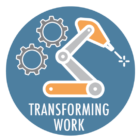
The New York Times in an article entitled Jim Farley tries to reinvent Ford and catch up to Elon Musk and Tesla writes:
Yet Wall Street still thinks that Tesla, which is worth more than $1 trillion, will dominate the industry and that companies like Ford, worth $62 billion, and G.M., $58 billion, will become relative minnows.
The possibility of Ford and G.M. becoming mobility industry minnows should terrify state policymakers and economic development leaders. Because if they are minnows––minor players in the new electric, autonomous, connected mobility industry––Michigan will be well on its way to being Michissippi. One of the nation’s least prosperous states.
What made Michigan one of the most prosperous places on the planet for most of the 20th century was not making motor vehicles, but inventing, designing and developing both the vehicle and the process for making vehicles. We were the early 20th Century’s Silicon Valley: the place where the next economy was invented and commercialized.
Michigan’s position as the North American center of the auto industry is still a function of our being the place where internal-combustion, non-autonomous, non-connected vehicles are designed and developed. And being the center of the North American auto industry is a central component of Michigan’s current diminished prosperity.
Michigan can only retain its position as the North American center of the auto industry if we are the place where mobility industry vehicles, propulsion system(s) and software in the vehicle are invented, designed and developed. And that increasingly is software-development driven. As Ford CEO Jim Farley explains in a terrific New Yorker article:
The electrification of Ford’s fleet isn’t the most challenging task that the company faces. As Jim Farley explained after my Rouge tour, “This industry is overly focused on the propulsion change. But the real change is that we are moving to a software-defined experience for our customers.” That experience will gradually replace what drivers do now, until Ford’s fleet becomes fully autonomous, at some point years from now. “Can we sleep in our cars?” Farley asked, in a way that suggested the answer will be yes. “Can we use them as business places, so we leave for work an hour later?” Again, yes. “Then the drive totally changes.
… Farley pointed to the recent history of the mobile phone as “the most powerful proxy for what we are going through.” In 2007, he went on, “three of the biggest mobile-phone-makers were BlackBerry, Nokia, and Motorola.” A few years later, Apple- and Google-made mobile devices took over, and they were much more than telephones. “And the most important thing was that the software decided what kind of hardware got put on those machines,” Farley added. When it came to the device business, hardware-centric companies had given way to software-first ones, and the customer experience was defined by the embedded operating system.
The transition to a software-driven industry means that losing the Rivian headquarters to California is far more important to Michigan’s future prosperity than where electric vehicles are assembled or batteries are made. And even more important to Michigan’s future prosperity is the success of Ford’s new Corktown facility. The place where Ford is centering their invention, design, development and commercialization of electric, autonomous and connected vehicles.
Detroit Three assembly and battery plants in states like Tennessee and Kentucky, and Michigan too, will be of little value if the Detroit Three are the equivalent of BlackBerry, Nokia, and Motorola.
What should terrify the rest of us is the lack of evidence that any state policymaker of either party or any economic development leader is terrified at the possibility of the Detroit Three being mobility industry minnows.
To make matters worse, the auto/mobility industry’s Lansing representatives are, by and large, missing in action. Focused almost exclusively on Michigan winning assembly and battery plants. Pushing for more and more taxpayer subsidies for factories and for an education system that pushes others’ kids into the skilled trades to work in those factories.
Being competitive for factories and training for factory-floor skilled trade workers is not what will determine whether the Detroit Three are mobility industry minnows or not. That will be determined by whether Michigan has the talent necessary to be the place where the new software-driven mobility industry is invented, designed and developed.
That requires a fundamental transformation in Michigan’s economic strategy. From factory focused to knowledge-enterprise focused. From competing for business investments based on low costs to competing for business investments on high talent––particularly young adults with four-year degrees or more––concentrations focused. To do that requires substantially higher public investments in education for all Michigan children from birth through college and in creating places where talent wants to live, work and play.
In a terrific Crain’s article entitled Why Ford’s Corktown project may mean more to Michigan’s future than the next battery plant, Chad Livengood lays out the required transformation in Michigan economic policy:
Despite the enormous potential Ford’s train station project has for both Detroit and Michigan, policymakers here are still chasing jobs assembling batteries instead of jobs inventing new technologies to make batteries capable of propelling an F-150 from Monroe to Mackinaw City and back on a single charge.
In response to Ford dissing its home state over shovel-ready land and industrial electricity rates, Michigan’s policymakers from both political parties went straight back to an all-too-familiar economic development playbook: Buying hourly production jobs with taxpayer-funded incentives.
… But where is the new $1 billion investment in Michigan’s knowledge economy? Where is the workforce investment in the college degree-dependent automotive technology fields that can be traced to decades of prosperity in places like West Bloomfield Township, Novi and Ann Arbor?
There’s been no similar effort of that scale to, for example, invest in the education and retention of software developers to meet the needs of Ford, GM and Stellantis (the automaker formerly known as Fiat Chrysler Automobiles) — or Michigan’s nonautomotive corporate titans such as Dow, Whirlpool, Stryker, Steelcase and Amway.
Rather, there’s been a 20-year disinvestment in higher education in this state, which ranks dead last in state taxpayer-funded need-based financial aid for students.
This is the state of Michigan’s economic policy as it relates to creating more knowledge-based jobs, which, unlike manufacturing jobs, are actually growing.







